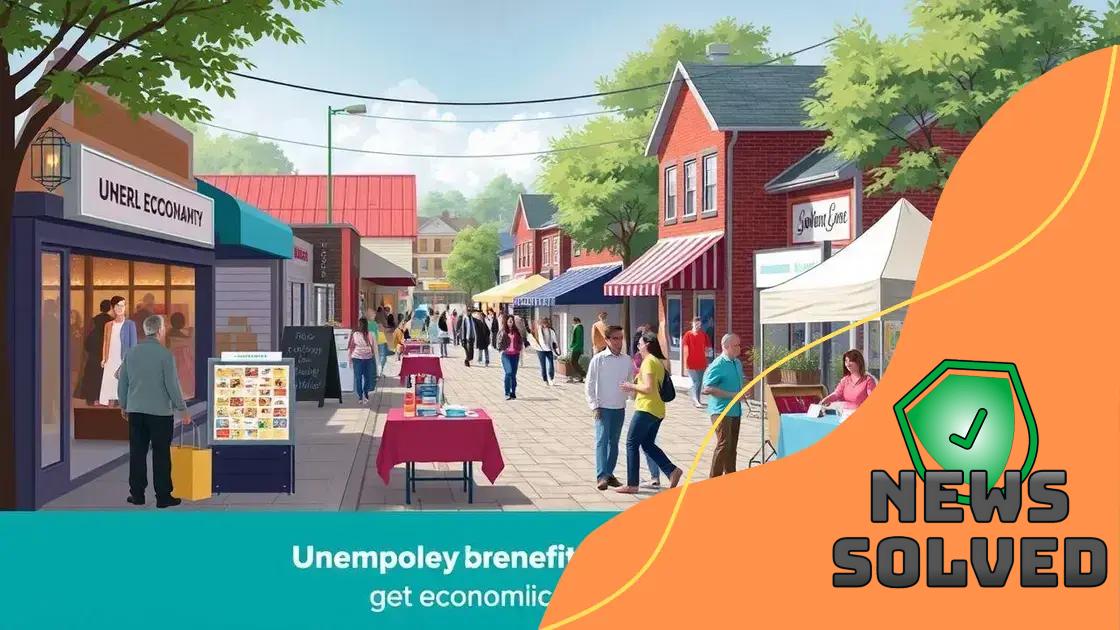The expansion of unemployment benefits during economic downturns

Advertisements
The expansion of unemployment benefits during economic downturns provides essential financial support to jobless individuals, helping stabilize the economy and encouraging a more skilled and satisfied workforce.
The expansion of unemployment benefits is a critical response during economic downturns, aiding those affected by job loss. Have you ever wondered how these benefits influence our economy and communities? Let’s explore.
Advertisements
Understanding unemployment benefits
Understanding unemployment benefits is essential for grasping how these financial aids support individuals during job loss. These benefits provide temporary assistance to those who are unemployed through no fault of their own.
What are unemployment benefits?
Unemployment benefits are government-provided financial assistance for unemployed individuals actively seeking work. They serve as a safety net, helping people meet their basic needs.
How are benefits calculated?
The amount of unemployment benefits a person can receive often depends on their previous earnings, the length of employment, and state regulations. Typically, these benefits can cover a fraction of lost wages.
Advertisements
- Calculations may vary by state.
- Average benefits usually range from $200 to $600 per week.
- Duration of benefits often lasts up to 26 weeks.
- Extensions may be available during economic downturns.
It’s important to note that not everyone qualifies for these benefits. Eligibility requirements often include having worked a certain number of hours or earned a minimum amount during a specific time period. Additionally, many states have different criteria that must be met.
Importance of unemployment benefits
Unemployment benefits play a crucial role in economic stability. By supporting those without jobs, they help maintain consumer spending during tough times. This, in turn, can help prevent deeper recessions.
Furthermore, these benefits encourage individuals to take the time to find suitable employment. Rather than rushing into the first available job, individuals receiving benefits can explore opportunities that better match their skills and career goals.
They also support local economies by allowing individuals to pay for essentials such as groceries, rent, and transportation, which keeps businesses afloat. In summary, understanding unemployment benefits reveals their vital role in both personal lives and broader economic health.
Historical context of unemployment benefits
Understanding the historical context of unemployment benefits helps us see how these programs evolved over time. Initially, these safety nets were scarce and limited to a few workers. However, various economic crises led to significant changes.
Early beginnings
Unemployment benefits have roots in the early 20th century. The need for assistance grew as industrialization changed job landscapes. By the 1930s, during the Great Depression, the U.S. government began implementing programs to help those without jobs.
Key milestones
Several milestones marked the development of unemployment benefits:
- 1935: The Social Security Act introduced unemployment insurance.
- 1970s: Changes increased accessibility and benefits.
- 1980s: More states expanded programs to include part-time workers.
- 2008: The Great Recession led to unprecedented extensions of benefits.
The expansion during the Great Recession was particularly significant. It reflected the urgency of economic support when millions lost jobs. These changes impacted not only individuals but also the broader economy, reinforcing the idea that helping the unemployed is vital in tough times.
As we move forward, the conversation continues about how best to support those affected by job loss. Debates surrounding eligibility requirements, benefit amounts, and the duration of assistance are crucial in shaping policies. The historical context of unemployment benefits illustrates the ongoing need for a responsive safety net during economic downturns.
Impacts on the economy and workforce

The impacts of unemployment benefits on the economy and workforce are significant and multifaceted. These benefits serve as a critical support system for individuals who lose their jobs, helping them meet basic needs while they search for new employment.
Short-term economic effects
In the short term, unemployment benefits help stabilize the economy. When people have money to spend, they boost local businesses. This spending helps keep stores open and workers employed, creating a chain reaction that benefits the entire community.
- Increased consumer spending during economic downturns.
- Support for local businesses facing reduced demand.
- Improvement in overall economic stability.
Moreover, during crises, such as a recession, extending unemployment benefits provides a safety net that prevents deeper economic declines. Many studies show that each dollar spent on unemployment benefits returns about $1.50 to $2.00 to the economy.
Long-term workforce impacts
The long-term impacts on the workforce are equally important. When people receive unemployment benefits, they can focus on finding a job that matches their skills and interests, rather than rushing to accept any available position. This can lead to better job alignment and employee satisfaction.
Additionally, these benefits often lead to investments in skill development. Unemployed individuals may take advantage of training programs or education opportunities funded through various initiatives, enhancing their employability in a changing job market.
However, there are fears that extended unemployment benefits might discourage people from looking for work. It is essential to balance support with incentives for job-seeking to ensure that the workforce remains active and engaged. The challenge lies in providing enough assistance without undermining the drive to return to work.
Comparative analysis of benefits in different countries
A comparative analysis of unemployment benefits in different countries reveals how various systems approach economic support for the unemployed. Each nation tailors its benefits based on economic conditions, cultural values, and social policies.
European models
Many European countries, such as Sweden and Germany, offer robust unemployment benefit systems. These systems generally include:
- Higher replacement rates, often covering a larger percentage of lost wages.
- Longer duration of benefits, extending for up to two years in some cases.
- Comprehensive support services, including job training and counseling.
This design promotes job security and encourages individuals to seek jobs that match their skills, ultimately benefiting the national economy.
United States system
In contrast, the United States has a more fragmented approach. Benefits can vary significantly from state to state. Some characteristics include:
- A maximum benefit amount that tends to be lower than in many European nations.
- Shorter duration of benefits, often capped at 26 weeks.
- Eligibility requirements that can be strict, limiting access.
While the U.S. system provides immediate assistance, there are ongoing debates regarding its effectiveness and coverage.
Emerging economies
In emerging economies, like India and Brazil, unemployment benefits are often less comprehensive. These systems usually provide minimal support and focus on:
- Basic financial aid with limited amounts.
- Informal support structures, such as family and community assistance.
- Incentives for self-employment or entrepreneurship.
As these economies develop, there is a growing conversation about enhancing benefits to better support their workforce and foster economic growth.
By studying the different models around the world, we can learn how to improve unemployment benefits systems. Observing what works in other countries can guide reforms that address gaps, enhance accessibility, and promote job suitability, ultimately leading to stronger economies globally.
Future of unemployment benefits in economic crises
The future of unemployment benefits during economic crises is shaped by ongoing changes in the workforce and the economy. As global job markets evolve, so must the systems that support unemployed individuals. Today, more people work in gig economy roles, which influences how benefits are structured.
Adapting to a changing workforce
With the rise of remote work and freelance jobs, traditional unemployment benefits may need to be modified. Many gig workers do not qualify for standard benefits, creating gaps in support. This raises important questions about how to ensure all workers have access to assistance when needed.
- Increased eligibility for gig workers and freelancers.
- Temporary benefits that can adjust to fluctuating job markets.
- Investment in digital platforms for more efficient application processes.
Policy makers are recognizing the need for a more inclusive approach to unemployment benefits, focusing on expanding coverage to all workers, regardless of their employment status.
Technological innovations
As technology evolves, it presents opportunities for streamlining benefit programs. Innovations like artificial intelligence can improve eligibility verification and reduce wait times for applicants. This means faster access to funds for those who need it the most.
Moreover, data analytics can help governments track unemployment trends, allowing for better planning and resource allocation during economic downturns. These tools can transform how benefits are administered, making systems more responsive to changing economic conditions.
Global collaboration
The future of unemployment benefits will likely also involve greater international collaboration. Countries can learn from each other’s successes and challenges. For example, the implementation of universal basic income (UBI) in some areas can spark discussions on how to integrate such policies into existing benefit frameworks.
By sharing research and strategies, countries can adapt quicker to economic crises, creating more resilient support systems for workers. Adapting unemployment benefits effectively will be crucial to maintaining economic stability and protecting workers in uncertain times.
The future of unemployment benefits is crucial as we face changing job markets and economic uncertainties. As we have seen, enhancing these benefits ensures that everyone has access to necessary support during tough times. By adapting to the needs of diverse workers, investing in technology, and learning from different global models, we can create a more effective safety net. This approach not only helps individuals but also strengthens our economy overall. Let’s continue working toward solutions that make employment support accessible and responsive for everyone.
FAQ – Frequently Asked Questions about Unemployment Benefits
What are unemployment benefits?
Unemployment benefits are payments made by the government to individuals who have lost their jobs, helping them meet their basic needs while they search for new work.
How are unemployment benefits calculated?
Benefits are typically based on previous earnings, with states determining the exact amounts and duration of payments.
Who qualifies for unemployment benefits?
Generally, individuals must have worked a certain number of hours or earned a minimum amount during a specified period, but eligibility varies by state.
How can technology improve the unemployment benefits process?
Technology can streamline applications and speed up processing times, making it easier for individuals to access benefits when they need them most.





